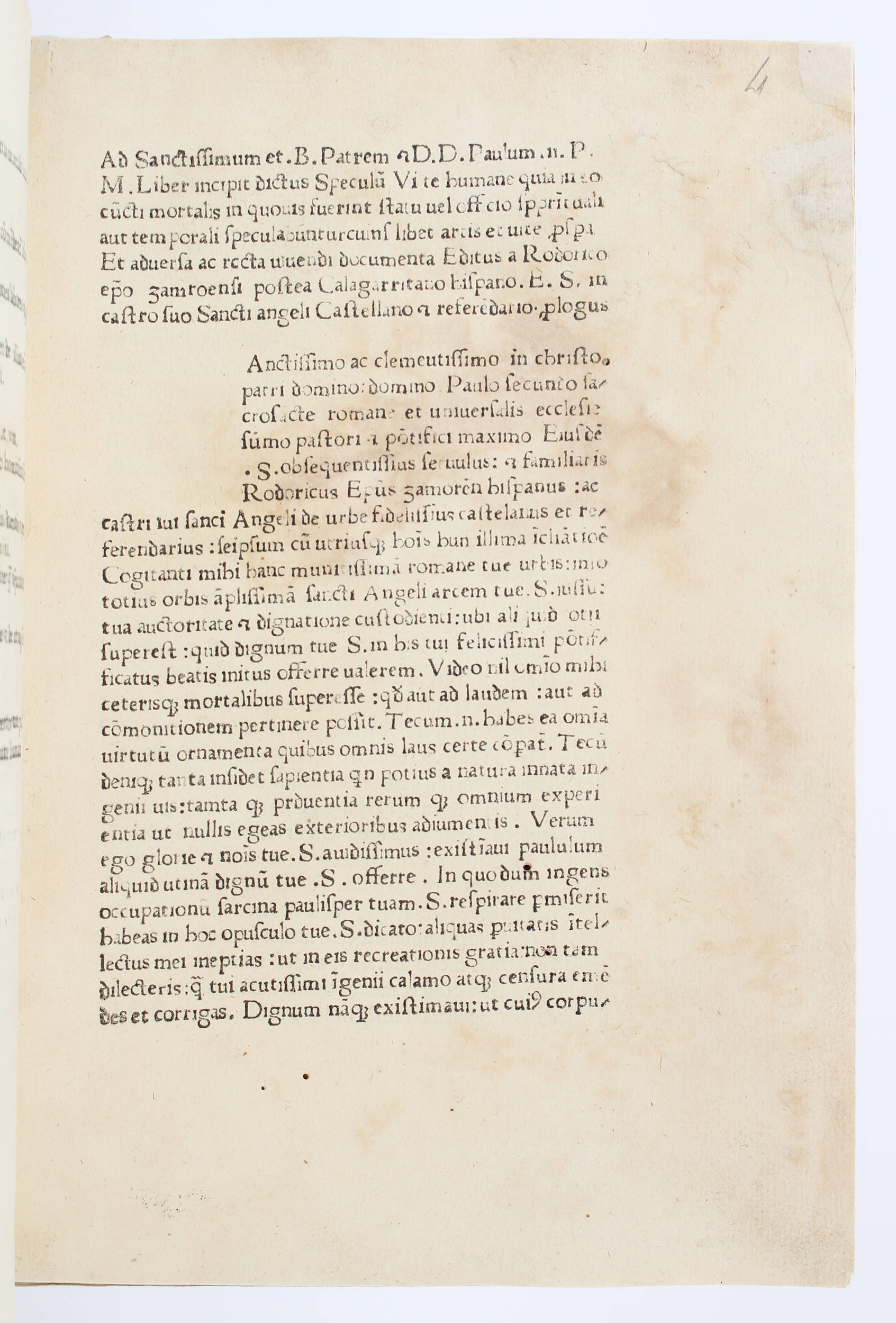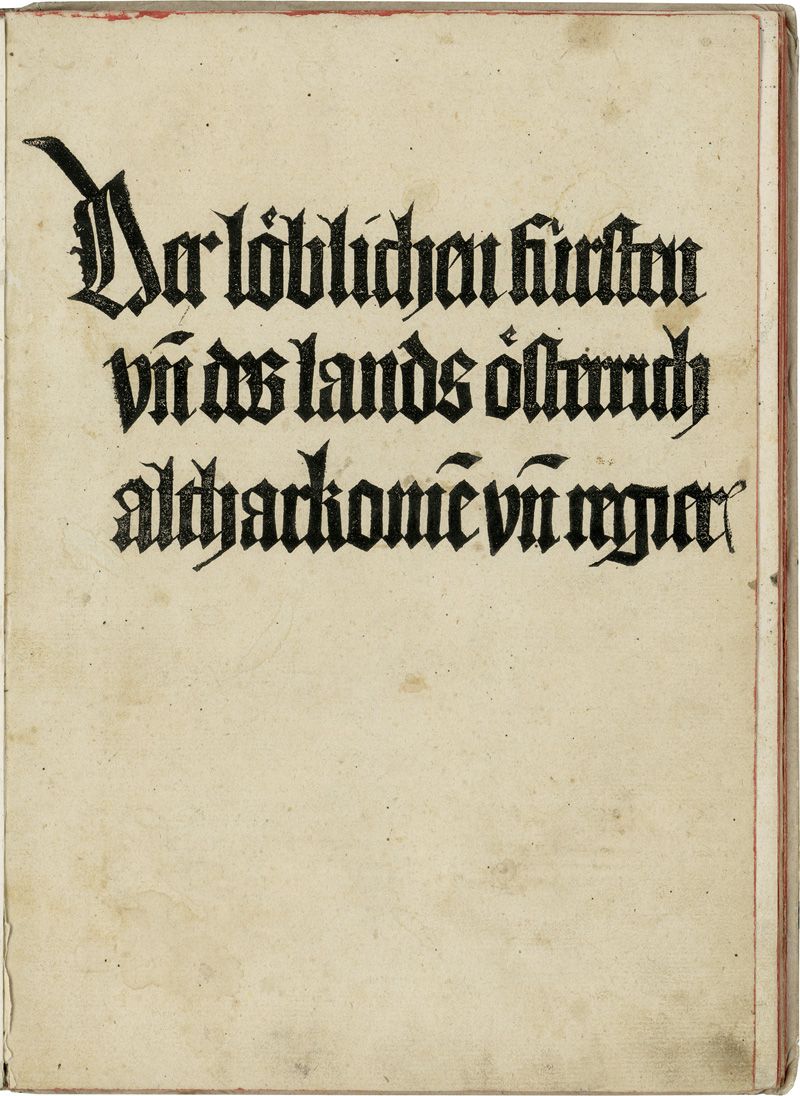RODERICUS ZAMORENSIS (1404-1470). Speculum vitae humanae . Augsburg: Günther Zainer 11 January 1471. Collation: [1-12 10 13 8 ] (1/1r dedicatory address to Pope Paul II, 1/2v preface, 1/4r chapter table, 1/8r text, 13/5v commendatory verse, colophon, 13/6 table). 128 leaves. 35 lines. Type: 2:118B. A line of type, omitted by the compositor, has been printed or stamped in by hand at the bottom of 6/8v as usual; 2- and 7-line initials in red, blue or green, a few incipits supplied in red, red paragraph marks, underlining and capital strokes, contemporary MS foliation. (Occasional marginal wormholes.) [ Bound with :] CRESCENTIIS, Petrus de (1230-c.1316). Ruralia commoda . [Augsburg]: Johann Schüssler, c. 16 February 1471. Collation: [1-17 10 18 10 (10+1) 19 10 (10+1) 20 10 (10+1) 21 8 ] (1/1r author's address to Amerigo de Placentia, chapter table, 1/4v author's address to Charles II, 1/5r text, 21/6r colophon, 216v-8 blank). 210 (of 211, without penultimate blank) leaves, final leaf used as rear pastedown. 35 lines. Type: 1:117G. 8-line initial opening text in red and green with contrasting decoration and extension, 2- and 6-line initials in red, blue or green, capital strokes in red; very occasional early MS quiring in lower margin. Pinholes often visible at extreme outer corners; numerous deckle edges retained. Variant in the colophon, agreeing with the Berlin and Chatsworth copies (cf. GW). (Faint marginal dampstain in a few leaves at end, tiny wormhole in final quire, occasional light marginal wormtrack.) 2 works in one volume, chancery 2° (291 x 216mm). Contemporary blindstamped polished pigskin over bevelled wooden boards, each side tooled to a different pattern with intersecting triple fillets, compartments tooled with palmette, fleur-de-lis, rosette, foliate and 'maria' tools (not in Kyriss or Schwenke-Sammlung ), 17th-century spine labels, 2 brass fore-edge clasps, vellum MS quire guards, single index tab indicating second work (labels worn, missing 10 centre and corner bosses and apparently an early label on front cover, a few small wormholes), citron linen folding box (front hinge broken). Provenance : Füssen, Bavaria, Benedictine monastery of St. Mang (contemporary inscription on first page, some early annotations) -- Princes von Oettingen-Wallerstein (rubberstamp; acquired most of the St. Mang library after the secularization of the monastery in 1803) -- Clifford Rattey (1886-1970, bookplate; his collection dispersed by Maggs Bros.) -- C.S. Ascherson (bookplate; collection sold to Bernard Quaritch in 1944/45). FINE COPIES OF THE SECOND EDITION OF THE SPECULUM VITAE HUMANAE , AND FIRST EDITION OF THE RURALIA COMMODA . The Speculum of Roderigo Sanchez de Arévala, bishop of Zamora, provides a strongly autobiographical moral treatise outlining the benefits and obligations of the various secular and religious stations of man. It was first printed at Rome in 1468 by Sweynheym and Pannartz (an edition given to Lauer at Rome in 1470 [H *13934] is a ghost) and proved immensely popular, being printed in at least 20 subsequent editions, including translations, in the 15th century. THE RURALIA COMMODA IS THE FIRST PRINTED BOOK ON AGRICULTURE and covers a wide range of topics, from hunting and fishing, wine-making, the cultivation of crops and grape-vines, trees and plants, and the medicinal use of plants, to animal husbandry and the diseases of cattle and horses. Crescentiis derived his knowledge from earlier treatises but wrote from experience applying and developing that knowledge on his own estate, the Villa d'Olmo, near Bologna. At least four collations exist for the final 4 quires of the Crescentiis. GW gives two versions, Oates a third, and the present copy represents a fourth, identical to Oates but with 8, not 10, leaves in the final quire. Misimposition presumably required the insertion of leaves, which are indicated by stubs still present in this copy. Rodericus Zamorensis: HC *13940; BMC II, 316 (IB.5419-20)
RODERICUS ZAMORENSIS (1404-1470). Speculum vitae humanae . Augsburg: Günther Zainer 11 January 1471. Collation: [1-12 10 13 8 ] (1/1r dedicatory address to Pope Paul II, 1/2v preface, 1/4r chapter table, 1/8r text, 13/5v commendatory verse, colophon, 13/6 table). 128 leaves. 35 lines. Type: 2:118B. A line of type, omitted by the compositor, has been printed or stamped in by hand at the bottom of 6/8v as usual; 2- and 7-line initials in red, blue or green, a few incipits supplied in red, red paragraph marks, underlining and capital strokes, contemporary MS foliation. (Occasional marginal wormholes.) [ Bound with :] CRESCENTIIS, Petrus de (1230-c.1316). Ruralia commoda . [Augsburg]: Johann Schüssler, c. 16 February 1471. Collation: [1-17 10 18 10 (10+1) 19 10 (10+1) 20 10 (10+1) 21 8 ] (1/1r author's address to Amerigo de Placentia, chapter table, 1/4v author's address to Charles II, 1/5r text, 21/6r colophon, 216v-8 blank). 210 (of 211, without penultimate blank) leaves, final leaf used as rear pastedown. 35 lines. Type: 1:117G. 8-line initial opening text in red and green with contrasting decoration and extension, 2- and 6-line initials in red, blue or green, capital strokes in red; very occasional early MS quiring in lower margin. Pinholes often visible at extreme outer corners; numerous deckle edges retained. Variant in the colophon, agreeing with the Berlin and Chatsworth copies (cf. GW). (Faint marginal dampstain in a few leaves at end, tiny wormhole in final quire, occasional light marginal wormtrack.) 2 works in one volume, chancery 2° (291 x 216mm). Contemporary blindstamped polished pigskin over bevelled wooden boards, each side tooled to a different pattern with intersecting triple fillets, compartments tooled with palmette, fleur-de-lis, rosette, foliate and 'maria' tools (not in Kyriss or Schwenke-Sammlung ), 17th-century spine labels, 2 brass fore-edge clasps, vellum MS quire guards, single index tab indicating second work (labels worn, missing 10 centre and corner bosses and apparently an early label on front cover, a few small wormholes), citron linen folding box (front hinge broken). Provenance : Füssen, Bavaria, Benedictine monastery of St. Mang (contemporary inscription on first page, some early annotations) -- Princes von Oettingen-Wallerstein (rubberstamp; acquired most of the St. Mang library after the secularization of the monastery in 1803) -- Clifford Rattey (1886-1970, bookplate; his collection dispersed by Maggs Bros.) -- C.S. Ascherson (bookplate; collection sold to Bernard Quaritch in 1944/45). FINE COPIES OF THE SECOND EDITION OF THE SPECULUM VITAE HUMANAE , AND FIRST EDITION OF THE RURALIA COMMODA . The Speculum of Roderigo Sanchez de Arévala, bishop of Zamora, provides a strongly autobiographical moral treatise outlining the benefits and obligations of the various secular and religious stations of man. It was first printed at Rome in 1468 by Sweynheym and Pannartz (an edition given to Lauer at Rome in 1470 [H *13934] is a ghost) and proved immensely popular, being printed in at least 20 subsequent editions, including translations, in the 15th century. THE RURALIA COMMODA IS THE FIRST PRINTED BOOK ON AGRICULTURE and covers a wide range of topics, from hunting and fishing, wine-making, the cultivation of crops and grape-vines, trees and plants, and the medicinal use of plants, to animal husbandry and the diseases of cattle and horses. Crescentiis derived his knowledge from earlier treatises but wrote from experience applying and developing that knowledge on his own estate, the Villa d'Olmo, near Bologna. At least four collations exist for the final 4 quires of the Crescentiis. GW gives two versions, Oates a third, and the present copy represents a fourth, identical to Oates but with 8, not 10, leaves in the final quire. Misimposition presumably required the insertion of leaves, which are indicated by stubs still present in this copy. Rodericus Zamorensis: HC *13940; BMC II, 316 (IB.5419-20)

.jpg)

.jpg)








Try LotSearch and its premium features for 7 days - without any costs!
Be notified automatically about new items in upcoming auctions.
Create an alert